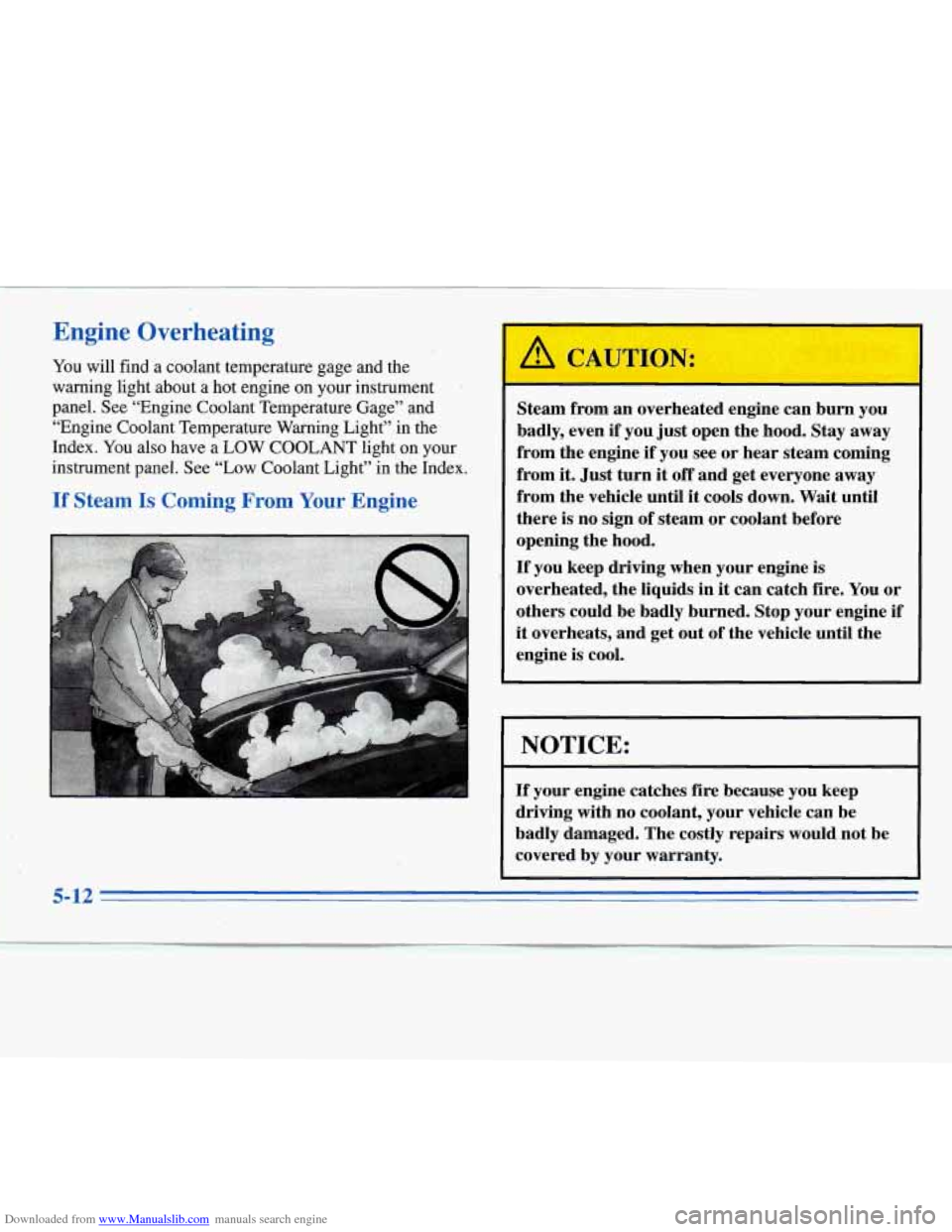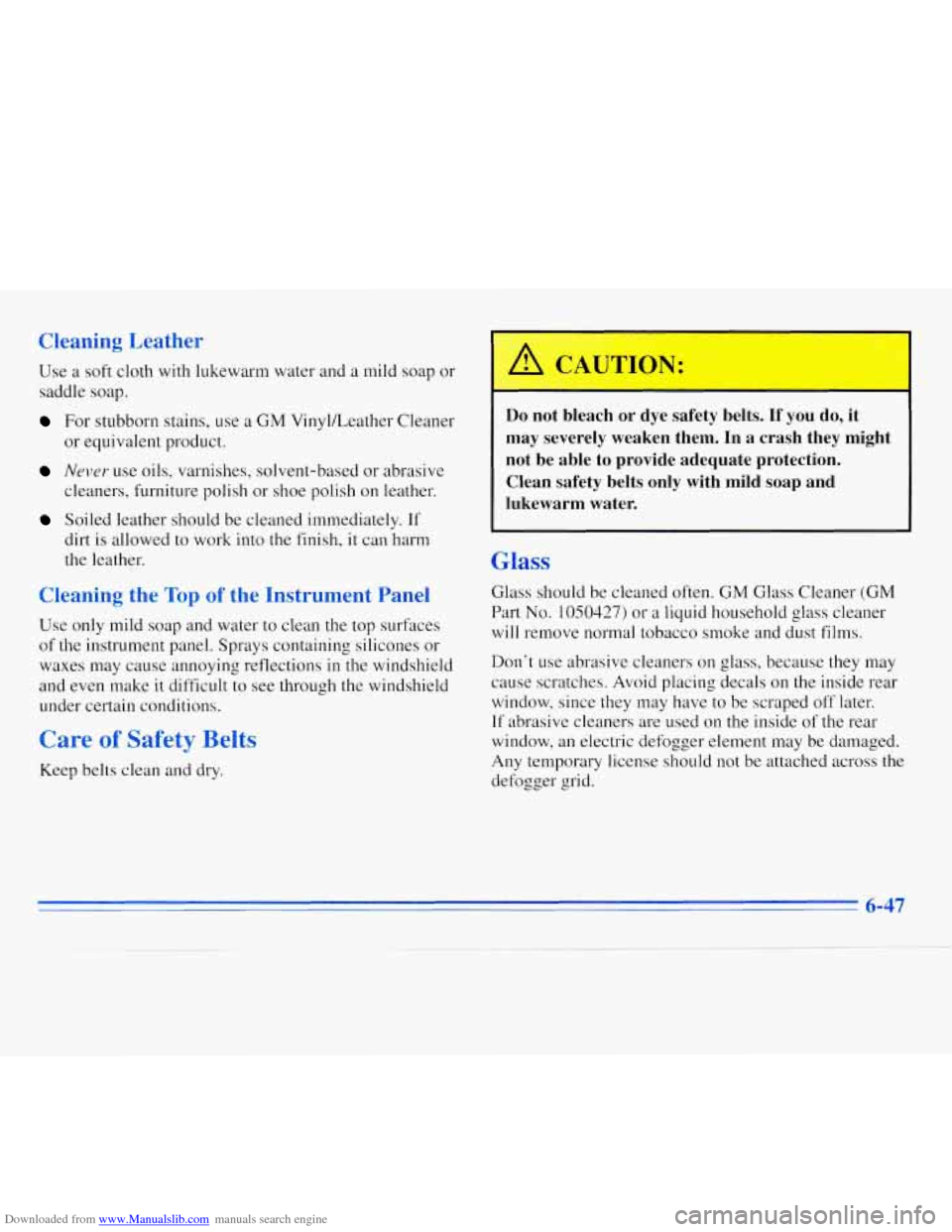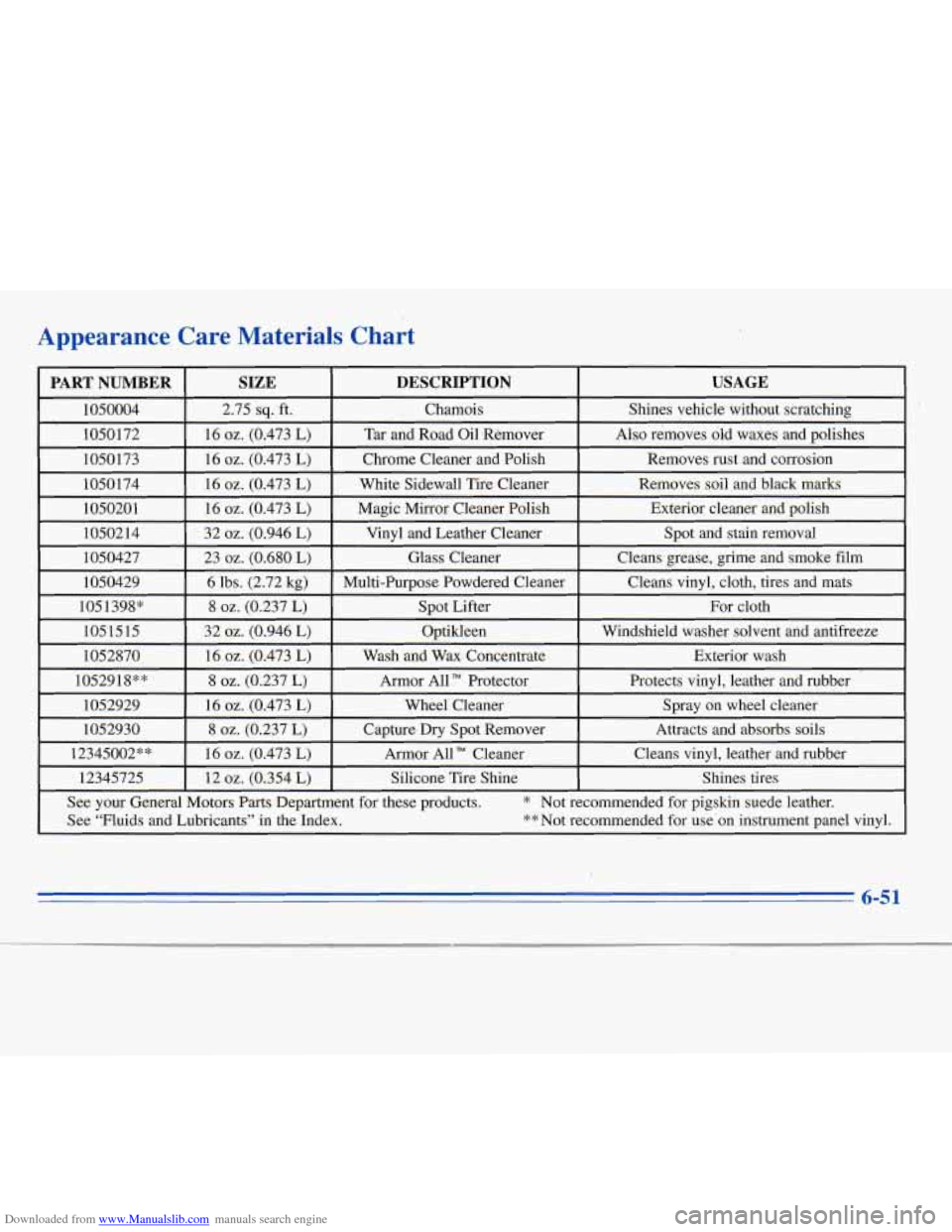1996 CHEVROLET MONTE CARLO instrument panel
[x] Cancel search: instrument panelPage 114 of 340

Downloaded from www.Manualslib.com manuals search engine Fan Knob
The knob with the fan symbol selects the force of air
you want. To turn the fan off, turn the knob to OFF.
Ten1perat.w-e Control
If your system does not have the auxiliary temperature
control option, the right knob changes the temperature
of the air coming through the system. Turn this knob
toward red (clockwise) for warmer air. Turn
it toward
blue (counterclockwise) for cooler air.
If your system does have the auxiliary temperature control
option, the center levers change the temperature of the air
coming through the system. The
DRIV lever sets the
temperature for the driver
and rear seat passengers, and
the
PASS lever sets the temperature for the front seat
passenger. For maximum defroster performance, set the
DRIV and PASS levers at full warm.
Mode Knob
The left knob has several settings to control the direction
of airflow. For each setting, set the temperature to
a
comfortable setting.
MAX: This setting recirculates much of the air inside
your vehicle and sends it through the instrument
panel outlets.
A/C: This setting brings in outside air and directs it
through the instrument panel outlets.
+fl BI-LEVEL: This setting brings in the outside
air and directs
it two ways. Half of the air is directed
through the instrument panel outlets. Most of the
remaining air
is directed through the floor ducts and a
little to
the defrost and side window vents.
+.
+e
/J VENT This setting brings in outside air and
directs
it through the instrument panel outlets.
'fl FLOOR: This setting sends most of the air
through the ducts near the floor. The rest comes out
of the defrost and side window vents.
+fl DEFOG: This setting allows half of the air to go
to the floor ducts and half to the defrost and side
window vents.
0
w.
9 DEFROST This setting directs most of the air
through
the defrost and side window vents. Some of the
air goes
to the floor ducts.
Page 169 of 340

Downloaded from www.Manualslib.com manuals search engine Making Turns
I NOTICE:
Making very sharp turns while trailering could
cause the trailer to come in contact with the
vehicle. Your vehicle could be damaged. Avoid
making very sharp turns while trailering.
When you’re turning with a trailer, make wider turns
than normal.
Do this so your trailer won’t strike soft
shoulders, curbs, road signs, trees or other objects.
Avoid jerky or sudden maneuvers. Signal well
in advance.
Turn Signals When Towing a Trailer
When you tow a trailer, your vehicle may need a
different turn signal flasher and/or extra wiring. Check
with your Chevrolet dealer. The green arrows on your
instrument panel will flash whenever you signal
a turn
or lane change. Properly hooked up, the trailer lamps
will also flash, telling other drivers you’re about to turn,
change lanes or stop. When
towing
a trailer, the green arrows on your
instrument panel will flash for turns even if the bulbs on
the trailer are burned
out. Thus, you may think drivers
behind you are seeing your signal when they are not. It’s
important to check occasionally to be sure the trailer
bulbs are
still working.
Driving On Grades
Reduce speed and shift to a lower gear before you start
down
a long or steep downgrade. If you don’t shift
down, you might have to
use your brakes so much that
they would get hot and no longer work well.
On
a long uphill grade, shift down and reduce your
speed to around
45 mph (70 km/h) to reduce the
possibility of engine and transaxle overheating.
If you are towing a trailer, you may want to drive in
DRIVE
(D) instead of AUTOMATIC OVERDRIVE (@)
(or, as you need to, a lower gear).
4-33
Page 184 of 340

Downloaded from www.Manualslib.com manuals search engine Engine Overheating
. e You will find a coolant temperature gage and the
. warning light about a hot engine on your instrument
panel. See “Engine Coolant Temperature Gage” and
“Engine Coolant Temperature Warning Light” in the
Index. You also have a LOW COOLANT light on your
instrument panel. See “Low Coolant Light” in the Index.
If Steam Is Coming From Your Engine
-
Steam from an overheated engine can burn you
badly, even
if you just open the hood. Stay away
from the engine
if you see or hear steam coming
from
it. Just turn it off and get everyone away
from the vehicle until it cools down. Wait until
there is no sign of steam or coolant before
opening the hood.
If you keep driving when your engine is
overheated, the liquids in it can catch fire. You or
others ‘could be badly burned. Stop your engine
if
it overheats, and get out of the vehicle until the
engine is cool..
NOTICE:
If your engine catches fire because you keep
driving with no coolant, your vehicle can be
badly damaged. The costly repairs would not be
covered
by your warranty.
5-12
Page 210 of 340

Downloaded from www.Manualslib.com manuals search engine You can be injured and your vehicle could be
damaged if you try to do service work on a
vehicle without knowing enough about it.
0 Be sure you have sufficient knowledge,
experience, and the proper replacement
parts and tools before you attempt any
vehicle maintenance task.
Be sure to use the proper nuts, bolts and
other fasteners. “English” and “metric”
fasteners can be easily confused. If you use
the
wrong fasteners, parts can later break
or fall off. You could be hurt.
Fuel
Use regular unleaded gasoline rated at 87 octane or higher.
At a.minimum, it should meet specificatiom.ASTM D4814
in the United States and
CGSB 3.5-M93 in Canada.
Improved gasoline specifications have been developed by
the American Automobile Manufacturers Association
(AAMA) for better vehicle performance and engine
protection. Gasolines meting
the AAMA specification
~~~ ~ ~~~
could provide improved driveability and emission control
system protection compared
to other gasolines.
Be sure the posted octane is at least 87. If the octane is
less than 87, you may get a heavy knocking noise when
you drive. If it’s bad enough, it can damage your engine.
If you’re using fuel rated at 87 octane or higher and you
still hear heavy knocking, your engine needs service.
But don’t worry if you hear a little pinging noise when
you’re accelerating or driving up a hill. That’s normal,
and you don’t have to buy a higher octane fuel to get rid
of pinging. It’s the heavy, constant knock that means
you have a problem.
If your vehicle is certified to meet California Emission
Standards (indicated on the underhood tune-up label),
it is designed to operate on fuels that meet California
specifications. If such fuels are not available in states
adopting California emissions standards, your vehicle
will operate satisfactorily on fuels meeting federal
specifications, but emission control system performance
may be affected. The malfunction indicator lamp on
your instrument panel may turn on and/or your vehicle
may fail a smog-check test.
If this occurs, return to your
authorized Chevrolet dealer for diagnosis to determine
the cause of failure. In the event it is determined that the
cause
of the condition is the type of fuels used, repairs
may not be covered by your warranty.
6-2
Page 211 of 340

Downloaded from www.Manualslib.com manuals search engine In Canada, some gasolines contain an octane-enhancing
additive called
MMT. If you use such fuels, your
emission control system performance may deteriorate
and the malfunction indicator lamp on your instrument
panel may turn on. If this happens, return to your
authorized Chevrolet dealer for service.
To provide cleaner air, all gasolines are now required to
contain additives that will help prevent deposits from
forming
in your engine and fuel system, allowing your
emission control system to function properly. Therefore,
you should not have to add anything to the fuel. In
addition, gasolines containing oxygenates, such
as ethers
and ethanol, and reformulated gasolines may be
available in your area to help clean the air. General
Motors recommends that you use these gasolines if they
comply
with the specifications described earlier.
NOTICE:
Your vehicle was not designed for fuel that
contains methanol. Don’t use it. It can corrode
metal parts in your fuel system and also damage
plastic and rubber parts. That damage wouldn’t be covered under your warranty.
Fuels in Foreign ‘loun
If you plan on driving in another country outside the
United States or Canada, the proper fuel may be hard
to find. Never use leaded gasoline or any other fuel not
recommended in the previous text on fuel. Costly repairs
caused by use of improper fuel wouldn’t be covered by
your warranty.
To check on fuel availability, ask an auto club, or
contact a major oil company that does business in the
country where you’ll be driving.
You can also write us at the following address for
advice. Just tell us where you’re going and give your
Vehicle Identification Number (VIN).
General Motors Overseas Distribution Corporation,
North American Export Sales (NAES)
1908 Colonel Sam Drive
Oshawa, Ontario LlH
8P7
6-3
Page 217 of 340

Downloaded from www.Manualslib.com manuals search engine Before closing the hood, be sure all the filler caps are on
properly. Then just pull
the hood down and close it firmly.
Engine Oil
LOW
OIL
If the LOW OIL light on the
instrument panel comes on,
it means
you need to check
your engine oil level right
away. For more
information, see “Low Oil
Level Light”
in the Index.
You should check your
engine oil level regularly;
this is an added reminder.
It’s a good idea to check your engine
oil after you get
fuel. In order to get an accurate reading, the oil must be
hot and the vehicle must be on level ground.
3.1 L L82 (Code M) Engine
The engine
oil dipstick handle is the yellow loop near
the front
of the engine.
6-9
Page 255 of 340

Downloaded from www.Manualslib.com manuals search engine Cleaning Leather
Use a soft cloth with lukewarm water and a mild soap or
saddle
soap.
For stubborn stains, use a GM Vinylkeather Cleaner
or equivalent product.
Never use oils, varnishes, solvent-based or abrasive
cleaners, furniture polish or shoe polish on leather.
Soiled leather should be cleaned immediately. If
dirt is allowed to work into the finish, it can harm
the leather.
Cleaning the Top of the Instrument Panel
Use only mild soap and water to clean the top surfxes
of
the instrument panel. Sprays containing silicones or
waxes may cause annoying reflections
in the windshield
and even make
it difficult to see through the windshield
under certain conditions.
Care of Safety Belts
Keep belts clean and dry.
/;1 4UTION:
Do not bleach or dye safety belts. If you do, it
may severely weaken them. In a crash they might
not be able to provide adequate protection.
Clean safety belts only with mild soap and
lukewarm water.
z
Glass
Glass should be cleaned often. GM Glass Cleaner (GM
Part No. 1050427) or a liquid household glass cleaner
will remove normal tobacco smoke and dust films.
Don’t use abrasive cleaners on glass, because
they may
cause scratches. Avoid placing decals on the inside rear
window, since they may have to be scraped off later.
If abrasive cleaners are used on the inside of the rear
window, an electric defogger element
may be damaged.
Any temporary license should not be attached across the
defogger grid.
Page 259 of 340

Downloaded from www.Manualslib.com manuals search engine Appearance Care Materia
PART NUMBER SIZE
1050004 16
oz. (0.473 L) 1050172 2.75
sq. ft.
32
02. (0.946 L) 1051515 8
02. (0.237 L) 105
1398"
6 lbs. (2.72 kg)
1050429 23
oz. (0.680
L)
1050427 32
oz. (0.946 L) 1050214 16
02. (0.473
L)
1050201 16
oz. (0.473
L)
1050174 16
oz. (0.473 L)
1050173
s Chart
1052870
8
oz. (0.237 L)
1052930 16
oz. (0.473 L)
1052929 8
oz. (0.237
L)
1052918** 16
oz. (0.473
L)
12345002"" 16
oz. (0.473 L)
DESCRIPTION USAGE
Chamois
Shines vehicle without scratching
Tar and Road Oil Remover
Spot and stain removal
Vinyl and Leather Cleaner Exterior cleaner
and polish
Magic Mirror Cleaner Polish Removes soil
and black marks
White Sidewall Tife Cleaner Removes
rust and corrosion
Chrome Cleaner and Polish Also
removes old waxes and polishes
Glass 'Cleaner
Cleans grease, grime and smoke film
Multi-Purpose Powdered Cleaner
Windshield washer solvent and antifreeze
Optikleen For
cloth
Spot Lifter Cleans vinyl, cloth,
tires and mats
Wash and Wax Concentrate Exterior wash
Armor All Protector
Spray on wheel cleaner
Wheel Cleaner Protects vinyl, leather
and rubber
Capture Dry Spot Remover Attracts and absorbs soils
Armor All Cleaner Cleans vinyl, leather
and rubber
Silicone Tire Shine Shines tires I I
12345725 I 12 oz. (0.354 L) I I
See
your General Motors Parts Department for these products. * Not recommended for pigskin suede leather.
I See "Fluids and Lubricants" in the-Index.
-
**Not recommended for use'on instrument panel vinyl. I
I ''
I
I 6-51